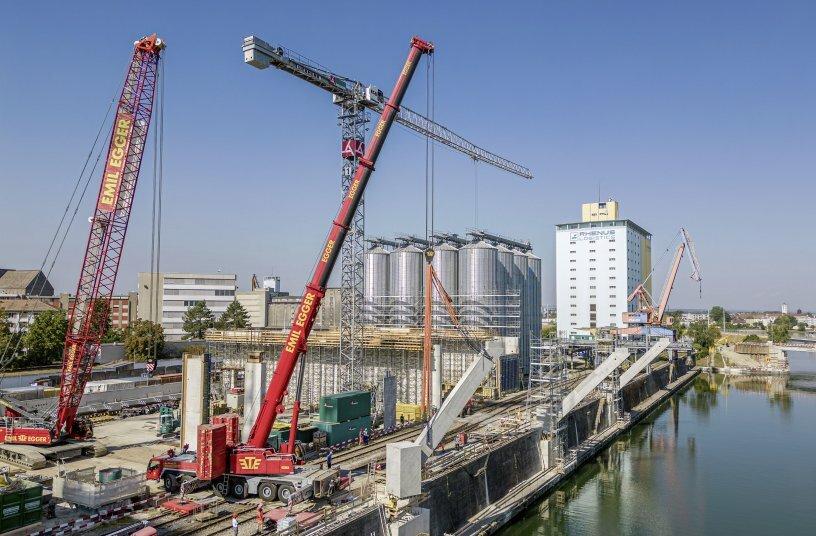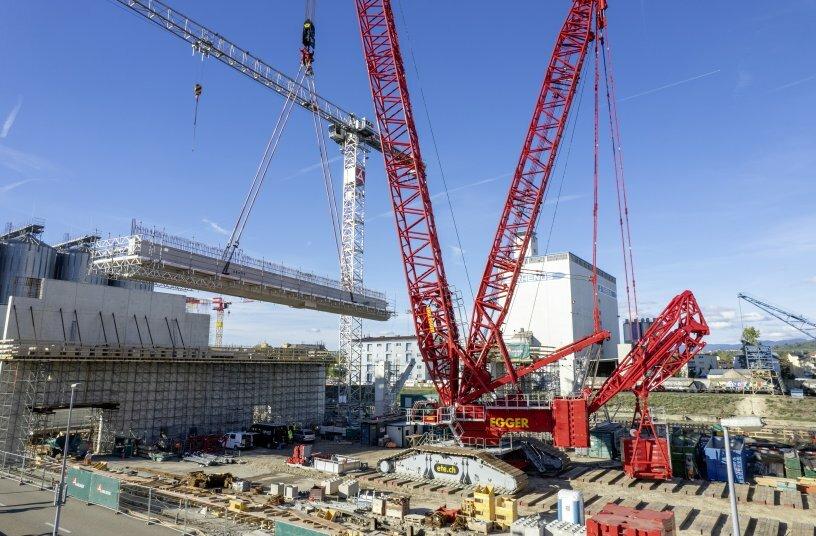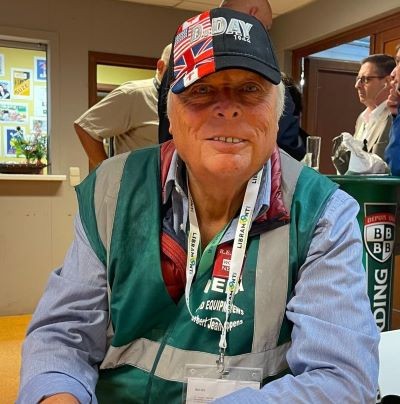Liebherr-Four Liebherr cranes from Emil Egger build trimodal transshipment terminal in Basel
 13/06/24-FR-English-NL-footer
13/06/24-FR-English-NL-footer
Quatre grues Liebherr d'Emil Egger construisent un terminal de transbordement trimodal à Bâle

 The LR 11000 moves a girder with a gross weight of 211 tonnes over a 59-metre radius. IMAGE SOURCE: Liebherr-Werk Ehingen GmbH-he V-frame allows the ballast radius to be reduced quickly and easily on confined construction sites.
The LR 11000 moves a girder with a gross weight of 211 tonnes over a 59-metre radius. IMAGE SOURCE: Liebherr-Werk Ehingen GmbH-he V-frame allows the ballast radius to be reduced quickly and easily on confined construction sites.
IMAGE SOURCE: Liebherr-Werk Ehingen GmbH
Rhenus Port Logistics développe un nouveau terminal de transbordement à Bâle-Kleinhünigen, en Suisse, d'une superficie de 7 300 mètres carrés.
Emil Egger AG a géré la logistique des éléments préfabriqués en béton, en déployant quatre grues Liebherr pour maximiser l'efficacité.
Le terminal comprendra cinq ponts roulants, des excavatrices, des chariots élévateurs, une trémie d'admission ferroviaire et des balances modernes pour le transport multimodal.
Les grues sur chenilles LR 1250 et LR 11000 ont effectué des tâches complexes, notamment le déplacement de supports lourds et l'installation de supports de chenilles.
Les grues mobiles LTM 1350-6.1 et LTM 1650-8.1 ont joué un rôle crucial dans le levage et le positionnement des supports diagonaux et des poutres osseuses.
Emil Egger AG maîtrise la logistique exigeante avec deux grues sur chenilles LR et deux grues mobiles LTM
Fonctionnement efficace dans toutes les phases de construction : LR 1250, LR 11000, LTM 1350-6.1 et
LTM1650-8.1
Tâches variées, conditions contraintes et processus de levage sophistiqués
Rhenus Port Logistics investit dans un nouveau terminal de transbordement dans le port rhénan de Bâle-Kleinhünigen (Suisse). Emil Egger AG a été chargée de la logistique des éléments préfabriqués en béton. Quatre grues Liebherr ont été déployées à Bâle pour maximiser l'efficacité pendant toutes les phases de construction.
Ehingen (Donau) (Allemagne), le 7 juin 2024 – D'une superficie totale de 7 300 mètres carrés, composé de cinq sections de halls et équipé d'une technologie de pointe, le nouveau terminal 4 est en construction dans le port rhénan. de Kleinhünigen . Ce terminal trimodal comprendra cinq ponts roulants capables de soulever jusqu'à 32 tonnes, ainsi que des excavatrices, des chariots élévateurs, une trémie d'admission ferroviaire pour les marchandises en vrac, ainsi que des ponts-bascules modernes pour la manutention et le transport des marchandises par route, rail et eau. Les grands supports en béton préfabriqués sont des éléments clés de la logistique portuaire en raison du grand porte-à-faux des poutres de grue utilisées pour charger et décharger les navires.
Emil Egger AG a été chargé de la logistique de ces éléments préfabriqués en béton. L'entreprise a déployé deux grues mobiles, une LTM 1350-6.1 et une LTM 1650-8.1, ainsi que deux grues sur chenilles, une LR 1250 et une LR 11000, pour relever de manière experte les défis sur site. L'accès à la zone de construction étant limité de tous côtés – tant par les bâtiments voisins que par la Südquaistrasse, qui ne pouvait pas être fermée, ainsi que par le Rhin – il était nécessaire de mettre en place une opération logistique fonctionnelle dans un espace très confiné. Les zones d'installation elles-mêmes n'étaient pas moins difficiles : elles étaient situées à l'intérieur du bâtiment naissant. Tout cela se faisant tandis que les travaux concrets se poursuivaient en parallèle.
Au cours du processus de construction, la LR 1250 a démonté le coffrage des supports diagonaux de 64 tonnes fabriqués sur place et les a transportés jusqu'au chantier de construction. La grue a ensuite chargé les supports sur des camions surbaissés pour le transport interne du site.
En automne, la LR 11000, la plus grande grue sur chenilles de Suisse, a installé les supports de voie de grue et les poutres osseuses externes, déplaçant ainsi deux supports pesant chacun 211 tonnes sur un rayon de 59 mètres. Quatre supports supplémentaires, pesant chacun 265 tonnes, ont été déplacés sur 45 mètres. La grue était configurée avec une flèche de 72 mètres de long et un châssis en V. « Nous avons utilisé le châssis en V pour la première fois il y a cinq ans et toute notre équipe ne peut plus imaginer utiliser cette puissante grue sans lui », explique Michael Egger d'Emil Egger. Même si les éléments de support préfabriqués, les échafaudages de façade et la route portuaire à côté du bâtiment limitaient considérablement la plage de rotation de la grue sur chenilles, des processus sophistiqués ont permis de gérer le ballast sans grue auxiliaire.
« Le VarioTray s'est également révélé inestimable : avec une petite palette et 180 tonnes de lest suspendu, les supports ont été soulevés, déplacés avec la grue et déplacés au-dessus de l'eau avec plus de 400 tonnes de lest suspendu – un moment fort de la phase de construction ! rapporte le chef de projet Andreas Schönenberger.
Les autres tâches de la grue sur chenilles de 1 000 tonnes consistaient notamment à étendre les panneaux muraux en béton coulé sur place jusqu'à la hauteur finale du hall. Cela a été suivi par l'installation de 14 poutres en os reliant les panneaux muraux. Chaque ascenseur impliquait une charge de 140 tonnes dans un rayon de 44 mètres et nécessitait des processus de montage et de démontage méticuleusement planifiés en raison de l'espace limité.
Déploiement de grues mobiles : démarrer et combler l'écart
Les tâches assignées au LTM 1350-6.1 comprenaient le levage des supports diagonaux, dont le coffrage avait été retiré par le LR 1250, du camion et leur inclinaison à l'angle correct afin qu'ils puissent ensuite être mis en place. Ces supports s'élèvent librement au-dessus de l'eau et soutiendront plus tard les poutres de la grue.
Entre autres tâches, la LR 1250 a retiré le coffrage des supports diagonaux de 64 tonnes (fabriqués sur place) et les a déplacés au sein du chantier.
Vers la fin de l'opération, le LTM 1650-8.1 a pris le relais, comblant les interstices dans les panneaux muraux en béton coulés sur place et installant les six dernières poutres osseuses. La nouvelle grue mobile a soulevé les poutres, qui pèsent environ 90 tonnes et mesurent 32 mètres de long, dans un rayon d'environ 14 mètres. Pour ce faire, la machine de 650 tonnes devait circuler sur le chantier après avoir installé chaque paire de poutres.
NJC.© Info Liebherr-Werk Ehingen GmbH
------------------------------------------------------------------------------------------------------------------
 13/06/24-English
13/06/24-English
Four Liebherr cranes from Emil Egger build trimodal transshipment terminal in Basel

 The LR 11000 moves a girder with a gross weight of 211 tonnes over a 59-metre radius. IMAGE SOURCE: Liebherr-Werk Ehingen GmbH-he V-frame allows the ballast radius to be reduced quickly and easily on confined construction sites.
The LR 11000 moves a girder with a gross weight of 211 tonnes over a 59-metre radius. IMAGE SOURCE: Liebherr-Werk Ehingen GmbH-he V-frame allows the ballast radius to be reduced quickly and easily on confined construction sites.
IMAGE SOURCE: Liebherr-Werk Ehingen GmbH
Rhenus Port Logistics is developing a new transshipment terminal in Basel-Kleinhünigen, Switzerland, spanning 7,300 square meters.
Emil Egger AG managed logistics for prefabricated concrete elements, deploying four Liebherr cranes to maximize efficiency.
The terminal will feature five bridge cranes, excavators, forklifts, a rail intake hopper, and modern scales for multimodal transportation.
The LR 1250 and LR 11000 crawler cranes handled complex tasks, including moving heavy supports and installing crane track supports.
The LTM 1350-6.1 and LTM 1650-8.1 mobile cranes were crucial in lifting and positioning diagonal supports and bone girders.
Emil Egger AG masters challenging logistics with two LR crawler cranes and two LTM mobile cranes
Efficient operation in all construction phases: LR 1250, LR 11000, LTM 1350-6.1 and
LTM 1650-8.1
Varied tasks, constrained conditions and sophisticated lifting processes
Rhenus Port Logistics is investing in a new transshipment terminal in the Rhine port of Basel-Kleinhünigen (Switzerland). Emil Egger AG was tasked with the logistics for the prefabricated concrete elements. Four Liebherr cranes were deployed in Basel to maximise efficiency during all construction phases.
Ehingen (Donau) (Germany), 7 June 2024 – Spanning a total area of 7,300 square metres, comprising five hall sections and equipped with state-of-the-art technology, the new Terminal 4 is being built in the Rhine port of Kleinhünigen. This trimodal terminal will include five bridge cranes capable of lifting up to 32 tonnes, along with excavators, forklifts, a rail intake hopper for bulk goods, as well as modern rail and truck scales for goods handling and transportation by road, rail and water. Large, prefabricated concrete supports are key elements in port logistics due to the large overhang of the crane girders used to load and unload ships.
Emil Egger AG was commissioned with the logistics for these prefabricated concrete elements. The company deployed two mobile cranes, an LTM 1350-6.1 and an LTM 1650-8.1, along with two crawler cranes, an LR 1250 and an LR 11000, to expertly handle the challenges on site. As access to the construction area is restricted on all sides – both by neighbouring buildings and Südquaistrasse, which could not be closed off, as well as by the Rhine – it was necessary to establish a functioning logistics operation within a very confined space. The installation areas themselves were no less challenging – they were located within the nascent building. All this being done while the concrete work continued in parallel.
During the construction process, the LR 1250 stripped the formwork from the 64-tonne diagonal supports fabricated on-site and transported them to the construction site. The crane subsequently loaded the supports onto low-loaders for internal site transport.
In autumn, the LR 11000, the largest crawler crane in Switzerland, installed the crane track supports and external bone girders, moving two supports weighing 211 tonnes each over a 59-metre radius. Four additional supports, each weighing 265 tonnes, were moved over 45 metres. The crane was configured with a 72-metre-long boom and V-frame. “We first used the V-frame five years ago and our entire team can no longer imagine operating this powerful crane without it,” says Michael Egger from Emil Egger. Despite the fact that the prefabricated support elements, façade scaffolding and the harbour road next to the building significantly limited the crawler crane’s slewing range, sophisticated processes made ballast management possible without an auxiliary crane.
“The VarioTray also proved invaluable: with a small pallet and 180 tonnes of suspended ballast, supports were lifted, moved with the crane and shifted over the water with over 400 tonnes of suspended ballast – a highlight of the construction phase!” reports project manager Andreas Schönenberger.
The 1,000-tonne crawler crane’s other tasks included extending the wall panels, made from cast-in-place concrete, up to the final height of the hall. This was followed by the installation of 14 bone girders connecting the wall panels. Each lift involved a 140-tonne load at a radius of 44 metres and required meticulously planned assembly and dismantling processes due to the limited space.
Mobile crane deployment: getting things started and closing the gap
The tasks assigned to the LTM 1350-6.1 included lifting the diagonal supports, from which the formwork had been stripped by the LR 1250, off the lorry and tilting them to the correct angle so that they could then be lifted into place. These supports cantilever freely over the water and will later support the crane girders.
Among other tasks, the LR 1250 removed the formwork from the 64-tonne diagonal supports (fabricated on-site) and moved them within the construction site.
Towards the end of the operation, the LTM 1650-8.1 took over, closing the gaps in the cast-in-place concrete wall panels and installing the last six bone girders. The new mobile crane lifted the beams, which weigh around 90 tonnes and are 32 metres long, at a radius of around 14 metres. To do this, the 650-tonne machine was required to drive within the construction site after installing each pair of beams.
NJC.© Info Liebherr-Werk Ehingen GmbH
----------------------------------------------------------------------------------------------------------------
 13/06/24-NL
13/06/24-NL
Vier Liebherr-kranen van Emil Egger bouwen trimodale overslagterminal in Bazel

 The LR 11000 moves a girder with a gross weight of 211 tonnes over a 59-metre radius. IMAGE SOURCE: Liebherr-Werk Ehingen GmbH-he V-frame allows the ballast radius to be reduced quickly and easily on confined construction sites.
The LR 11000 moves a girder with a gross weight of 211 tonnes over a 59-metre radius. IMAGE SOURCE: Liebherr-Werk Ehingen GmbH-he V-frame allows the ballast radius to be reduced quickly and easily on confined construction sites.
IMAGE SOURCE: Liebherr-Werk Ehingen GmbH
Rhenus Port Logistics ontwikkelt in Basel-Kleinhünigen, Zwitserland een nieuwe overslagterminal van 7.300 vierkante meter.
Emil Egger AG beheerde de logistiek voor geprefabriceerde betonelementen en zette vier Liebherr-kranen in om de efficiëntie te maximaliseren.
De terminal zal beschikken over vijf brugkranen, graafmachines, vorkheftrucks, een railinlaathopper en moderne weegschalen voor multimodaal transport.
De rupskranen LR 1250 en LR 11000 voerden complexe taken uit, waaronder het verplaatsen van zware steunen en het installeren van kraanbaansteunen.
De LTM 1350-6.1 en LTM 1650-8.1 mobiele kranen waren cruciaal bij het hijsen en positioneren van diagonale steunen en botliggers.
Emil Egger AG beheerst de uitdagende logistiek met twee LR-rupskranen en twee LTM mobiele kranen
Efficiënte werking in alle bouwfasen: LR 1250, LR 11000, LTM 1350-6.1 en
LTM 1650-8.1
Gevarieerde taken, beperkte omstandigheden en geavanceerde hefprocessen
Rhenus Port Logistics investeert in een nieuwe overslagterminal in de Rijnhaven van Basel-Kleinhünigen (Zwitserland). Emil Egger AG was belast met de logistiek voor de geprefabriceerde betonelementen. In Bazel werden vier Liebherr-kranen ingezet om de efficiëntie tijdens alle bouwfasen te maximaliseren.
Ehingen (Donau) (Duitsland), 7 juni 2024 – Met een totale oppervlakte van 7.300 vierkante meter, inclusief vijf halsecties en uitgerust met de modernste technologie, wordt in de Rijn de nieuwe Terminal 4 gebouwd haven van Kleinhünigen. Deze trimodale terminal zal vijf brugkranen omvatten die tot 32 ton kunnen hijsen, samen met graafmachines, vorkheftrucks, een spoorinlaathopper voor bulkgoederen, evenals moderne spoor- en vrachtwagenweegschalen voor goederenbehandeling en transport over de weg, het spoor en het water. Grote, geprefabriceerde betonnen steunen zijn sleutelelementen in de havenlogistiek vanwege de grote overhang van de kraanliggers die worden gebruikt voor het laden en lossen van schepen.
Emil Egger AG kreeg de opdracht voor de logistiek voor deze geprefabriceerde betonelementen. Het bedrijf zette twee mobiele kranen in, een LTM 1350-6.1 en een LTM 1650-8.1, samen met twee rupskranen, een LR 1250 en een LR 11000, om de uitdagingen ter plaatse vakkundig aan te pakken. Omdat de toegang tot het bouwgebied aan alle kanten beperkt is – zowel door aangrenzende gebouwen en de Südquaistrasse, die niet afgesloten konden worden, als door de Rijn – was het noodzakelijk om binnen een zeer beperkte ruimte een functionerende logistieke operatie op te zetten. De installatieruimtes zelf waren niet minder uitdagend; ze bevonden zich in het opkomende gebouw. Dit alles gebeurde terwijl het betonwerk parallel werd voortgezet.
Tijdens het bouwproces ontdeed de LR 1250 de bekisting van de ter plaatse vervaardigde diagonale steunen van 64 ton en transporteerde deze naar de bouwplaats. Vervolgens heeft de kraan de steunen op diepladers geladen voor intern terreintransport.
In het najaar installeerde de LR 11000, de grootste rupskraan van Zwitserland, de kraanbaansteunen en externe botliggers, waarbij twee steunen met elk een gewicht van 211 ton over een straal van 59 meter werden verplaatst. Vier extra steunen, elk met een gewicht van 265 ton, werden over 45 meter verplaatst. De kraan was geconfigureerd met een 72 meter lange giek en V-frame. “Vijf jaar geleden hebben we het V-frame voor het eerst gebruikt en ons hele team kan zich niet langer voorstellen deze krachtige kraan zonder te bedienen”, zegt Michael Egger van Emil Egger. Ondanks dat de geprefabriceerde steunelementen, gevelsteigers en de havenweg naast het gebouw het zwenkbereik van de rupskraan aanzienlijk beperkten, maakten uitgekiende processen ballastbeheer mogelijk zonder hulpkraan.
“Ook de VarioTray bleek van onschatbare waarde: met een kleine pallet en 180 ton zwevende ballast werden steunen gehesen, met de kraan verplaatst en met ruim 400 ton zwevende ballast over het water geschoven – een hoogtepunt van de bouwfase!” meldt projectmanager Andreas Schönenberger.
Tot de overige taken van de 1.000 ton wegende rupskraan behoorde het uitschuiven van de wandpanelen, gemaakt van ter plaatse gestort beton, tot de uiteindelijke hoogte van de hal. Daarna volgde de installatie van 14 beenliggers die de wandpanelen met elkaar verbonden. Elke lift omvatte een lading van 140 ton op een straal van 44 meter en vereiste vanwege de beperkte ruimte zorgvuldig geplande montage- en demontageprocessen.
Mobiele kraaninzet: aan de slag en het gat dichten
Tot de taken van de LTM 1350-6.1 behoorde onder meer het van de vrachtwagen halen en in de juiste hoek kantelen van de diagonale steunen, waarvan de bekisting door de LR 1250 was ontdaan, zodat deze vervolgens op hun plaats konden worden gehesen. Deze steunen vrij over het water en zullen later de kraanliggers ondersteunen.
De LR 1250 verwijderde onder meer de bekisting van de 64 ton zware diagonale steunen (ter plaatse vervaardigd) en verplaatste deze binnen de bouwplaats.
Tegen het einde van de operatie nam de LTM 1650-8.1 het over, waarbij de gaten in de ter plaatse gestorte betonnen wandpanelen werden gedicht en de laatste zes beenliggers werden geïnstalleerd. De nieuwe mobiele kraan heeft de balken, die zo'n 90 ton wegen en 32 meter lang zijn, in een straal van zo'n 14 meter gehesen. Om dit te doen, moest de machine van 650 ton na het installeren van elk paar balken binnen de bouwplaats rijden.
NJC.© Info Liebherr-Werk Ehingen GmbH
--------------------------------------------------------------------------------------------------------------
Date de dernière mise à jour : 12/06/2024















